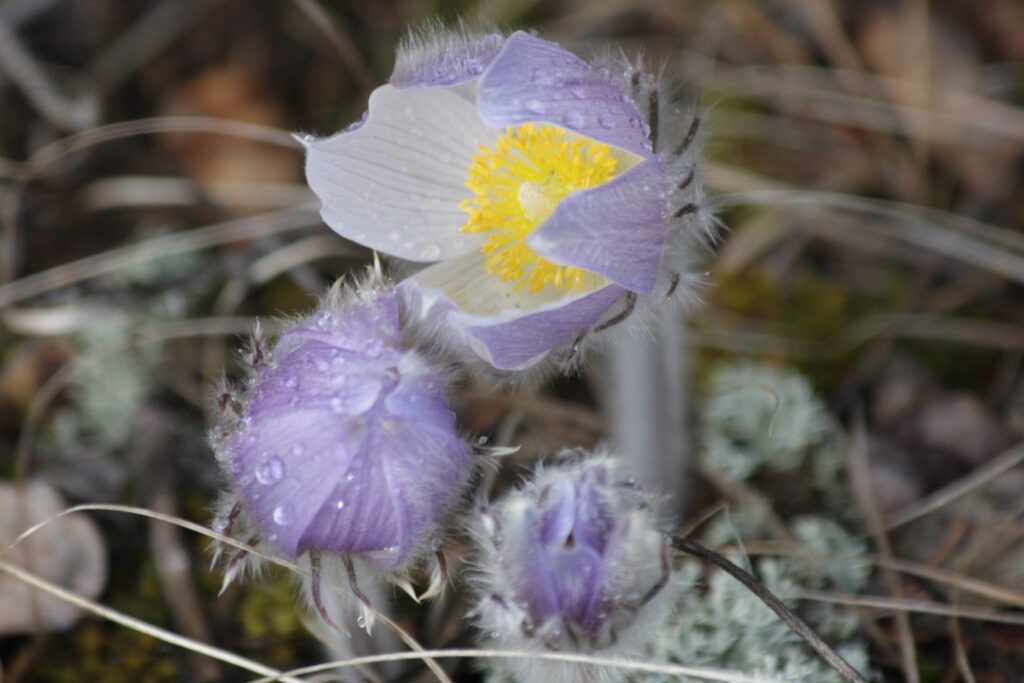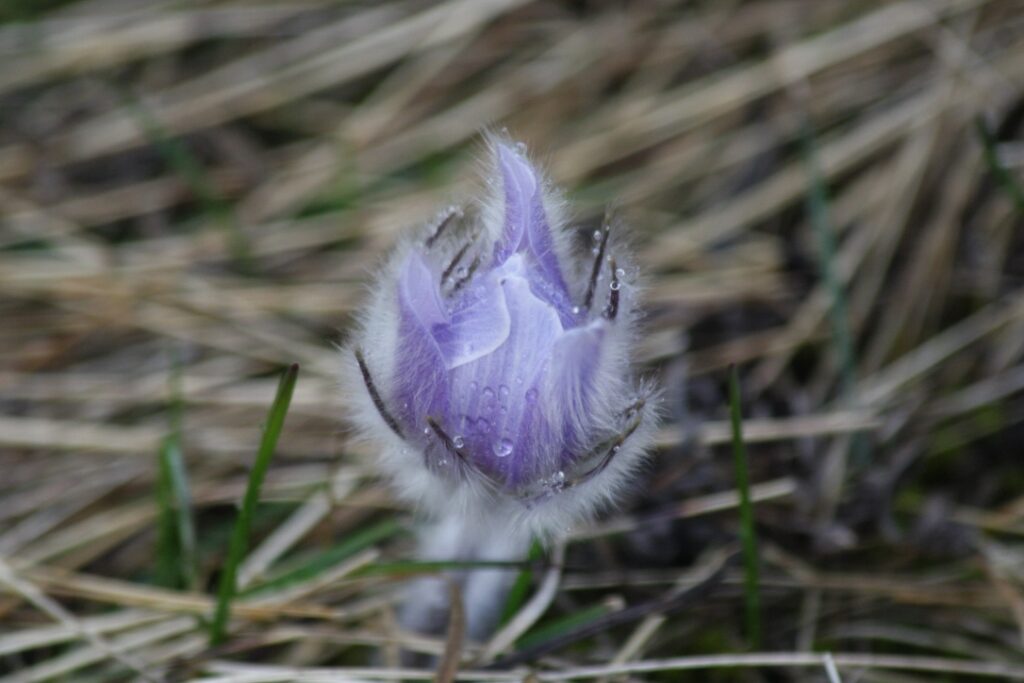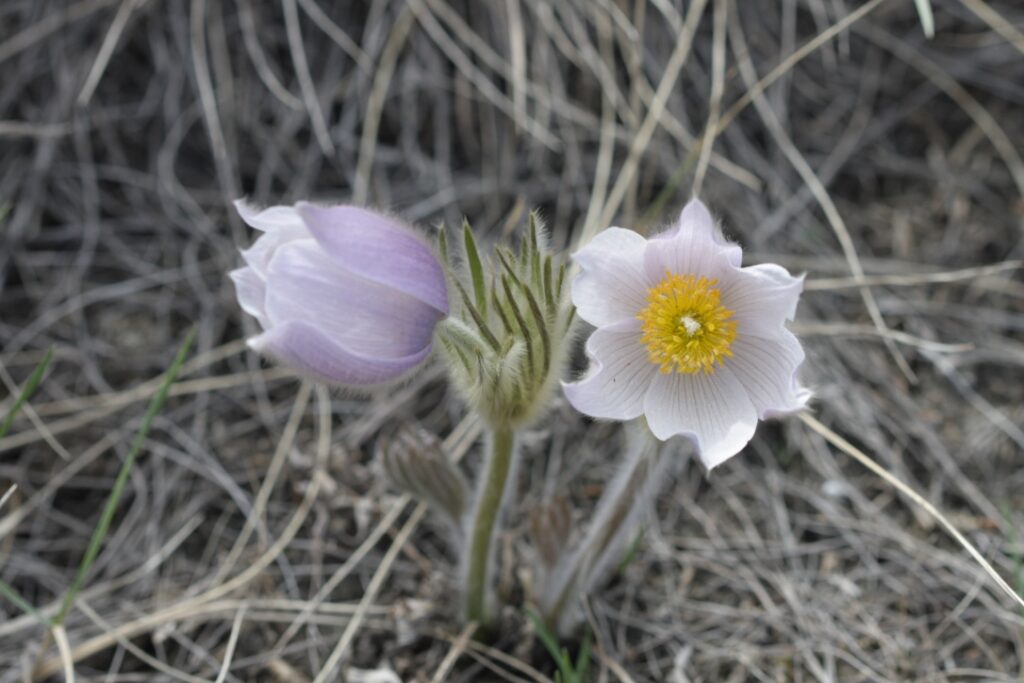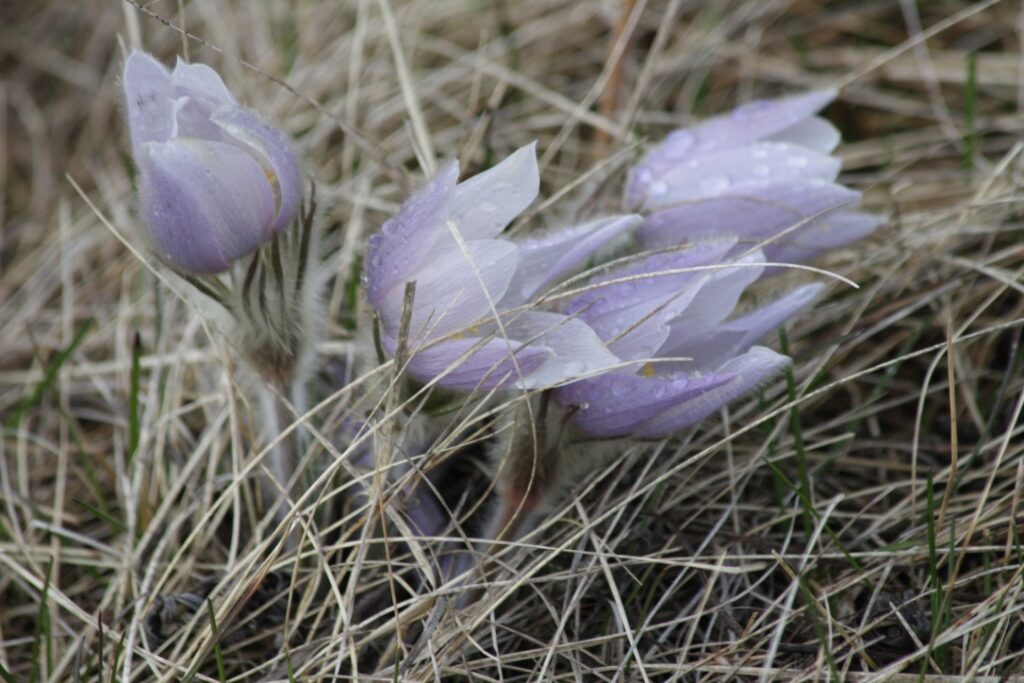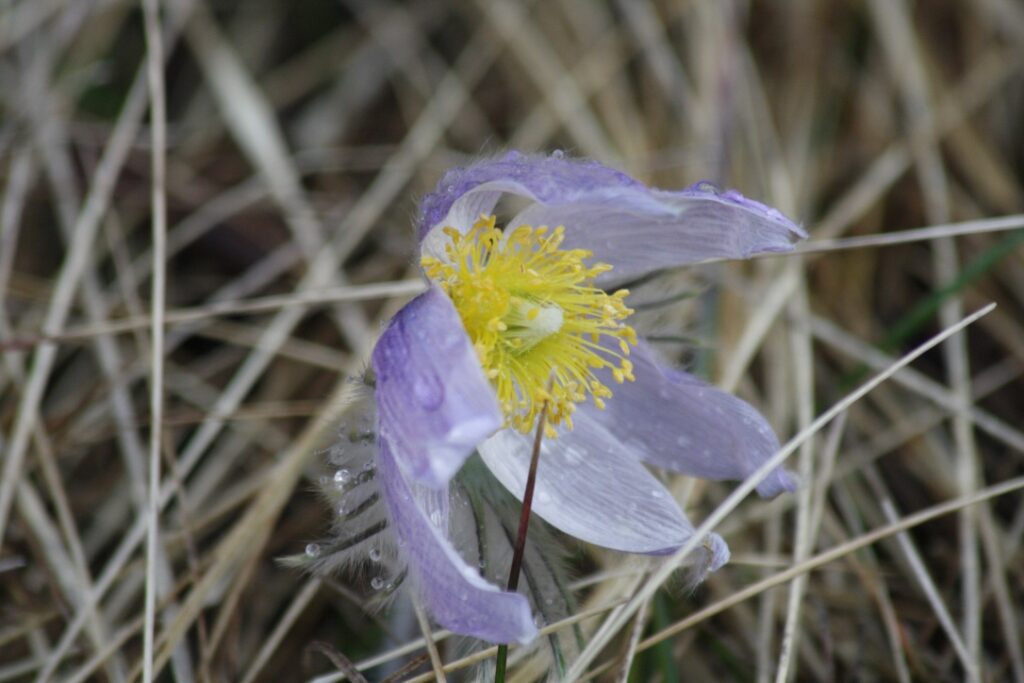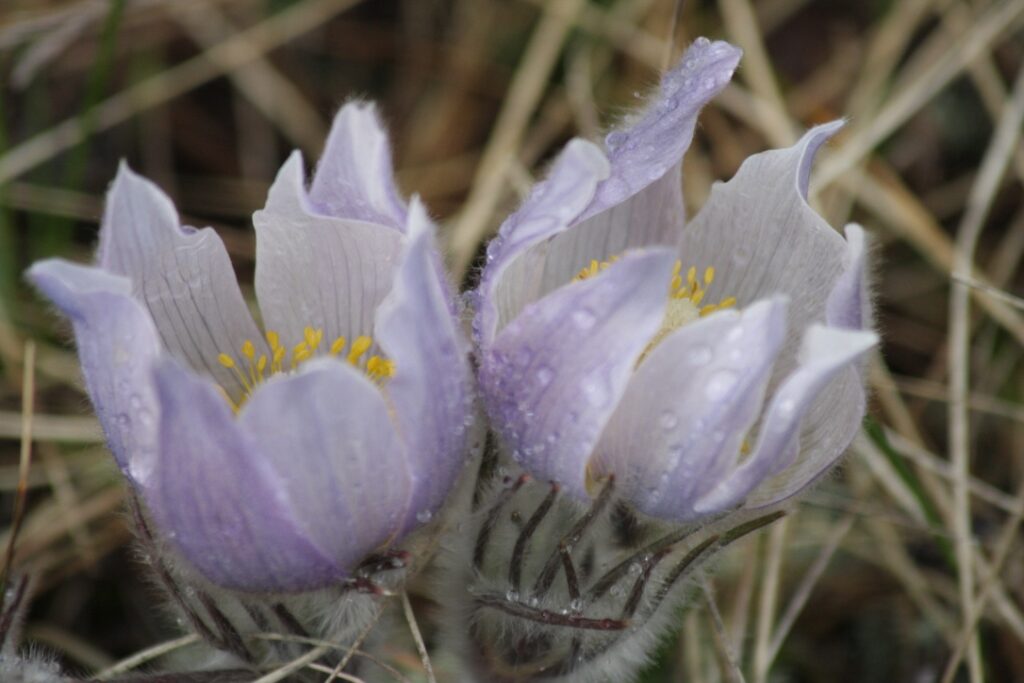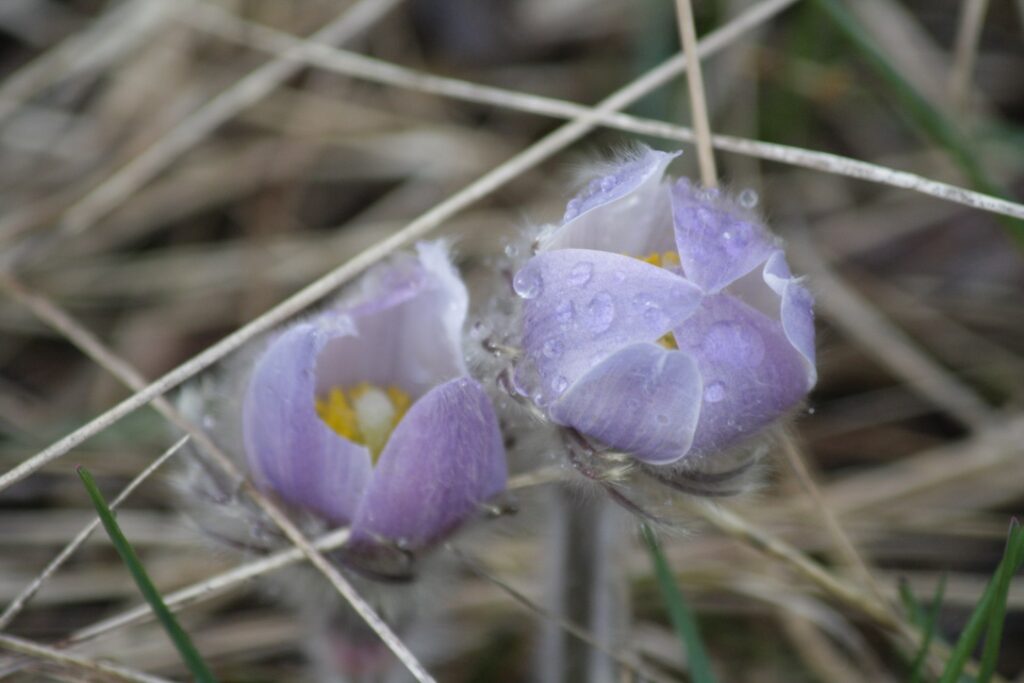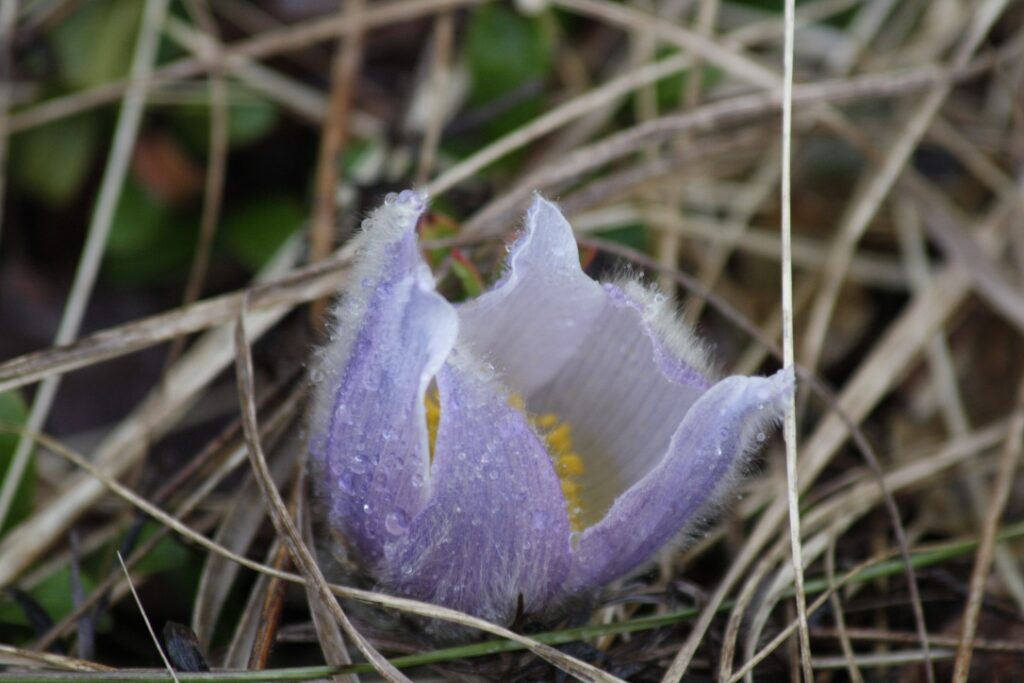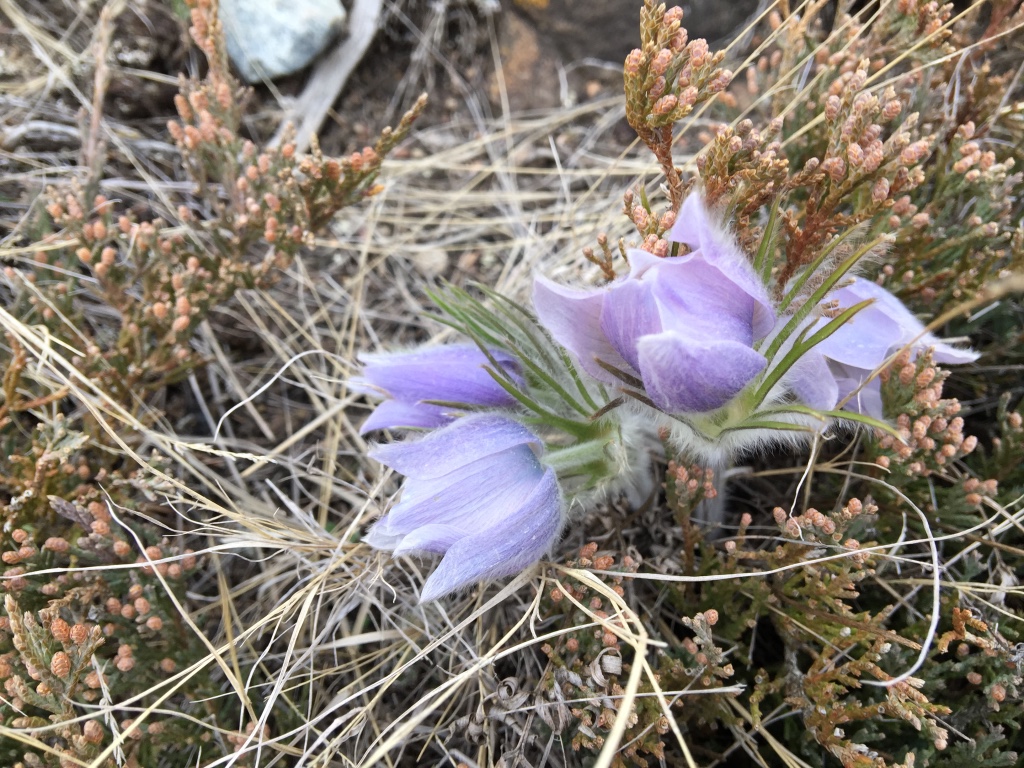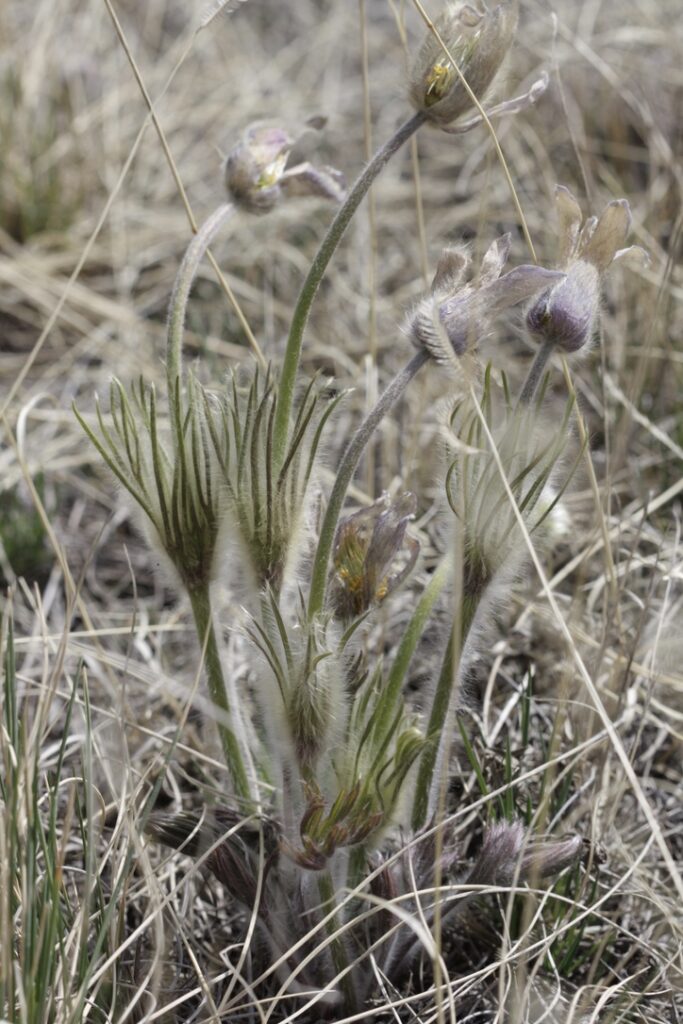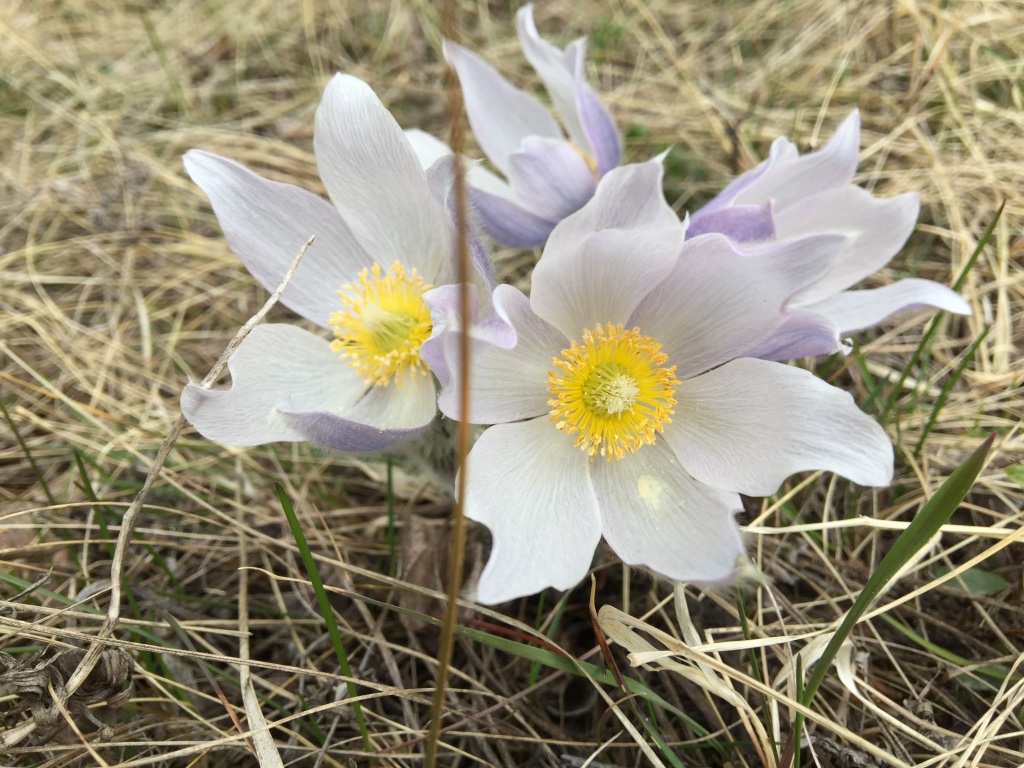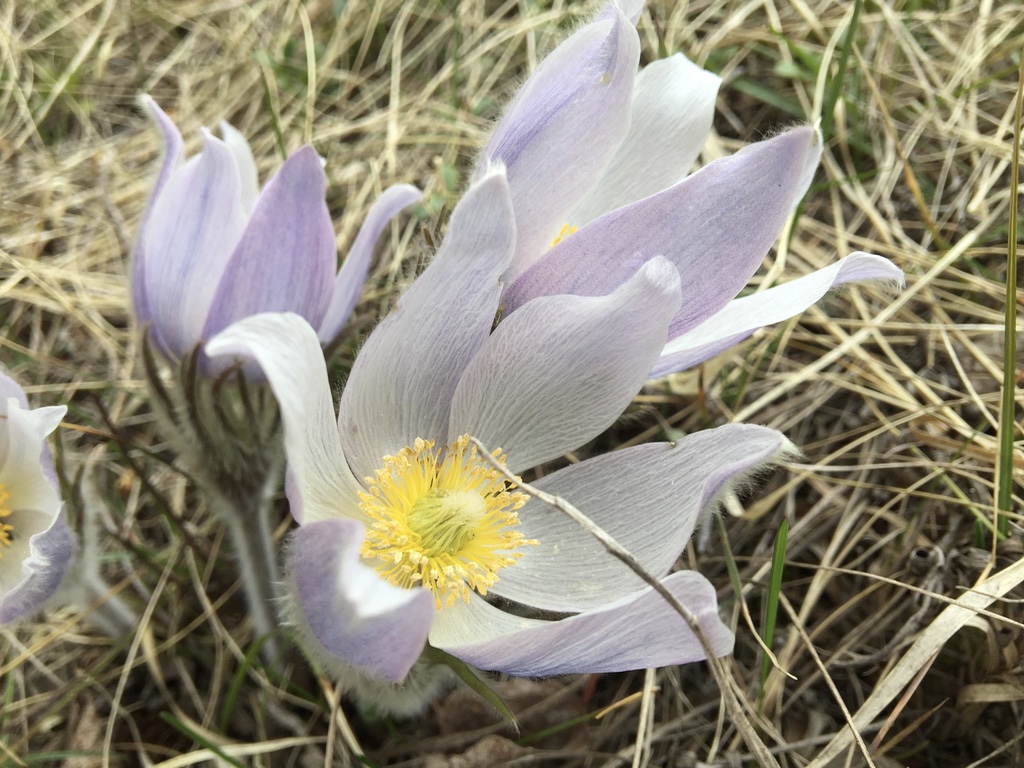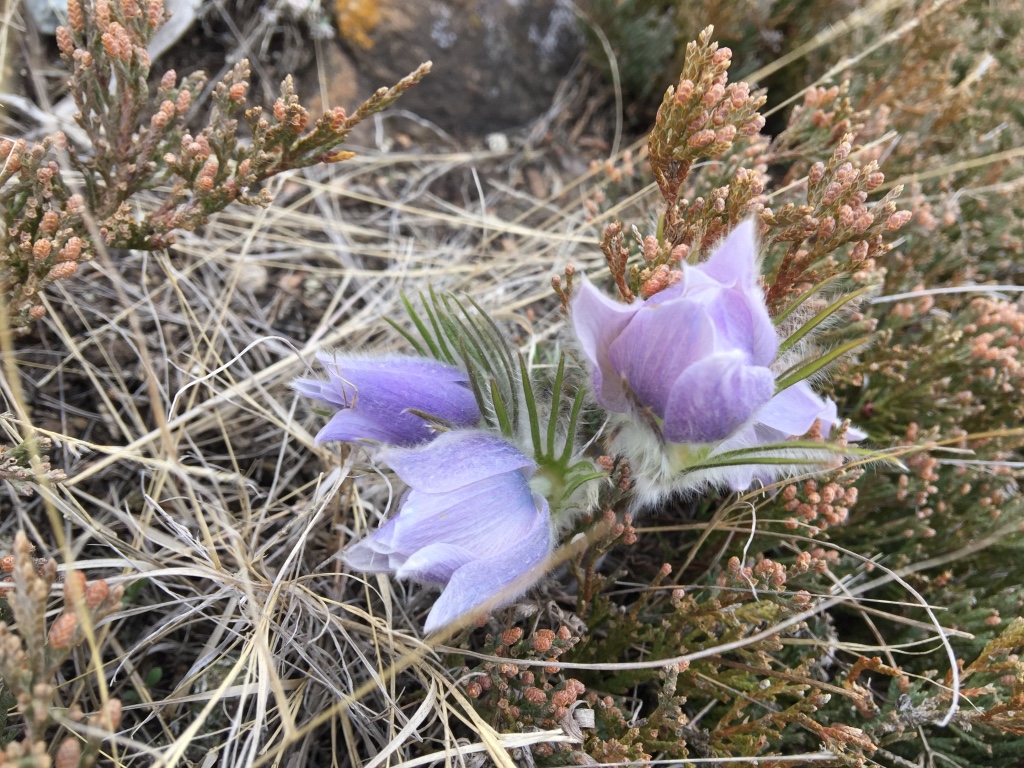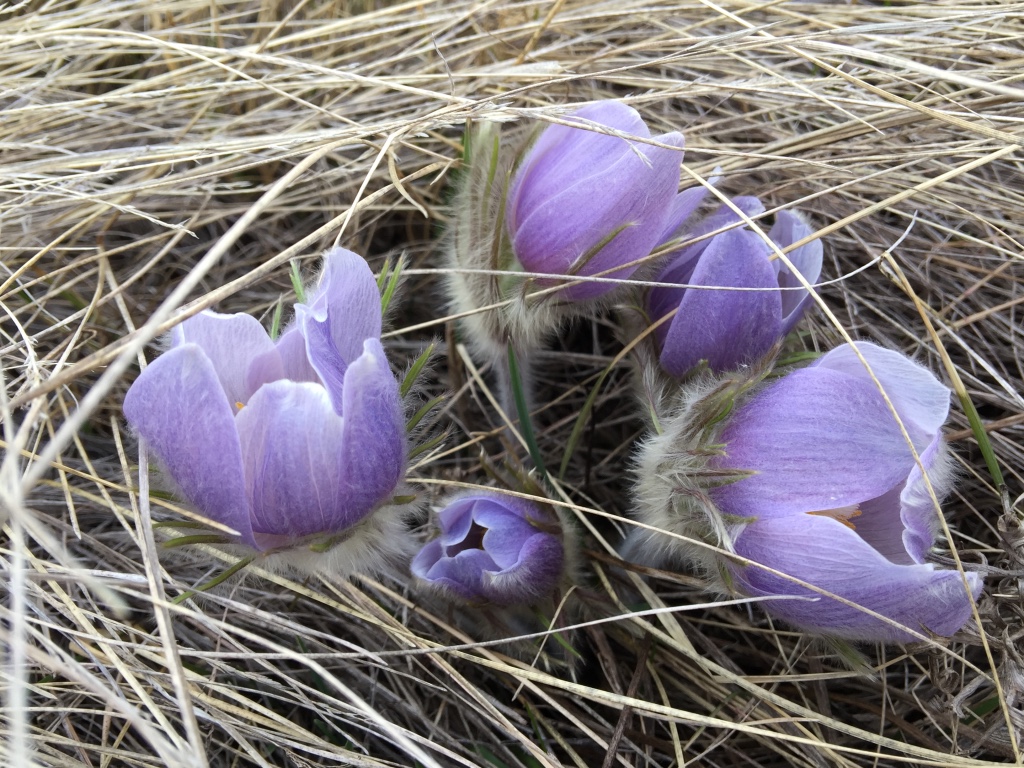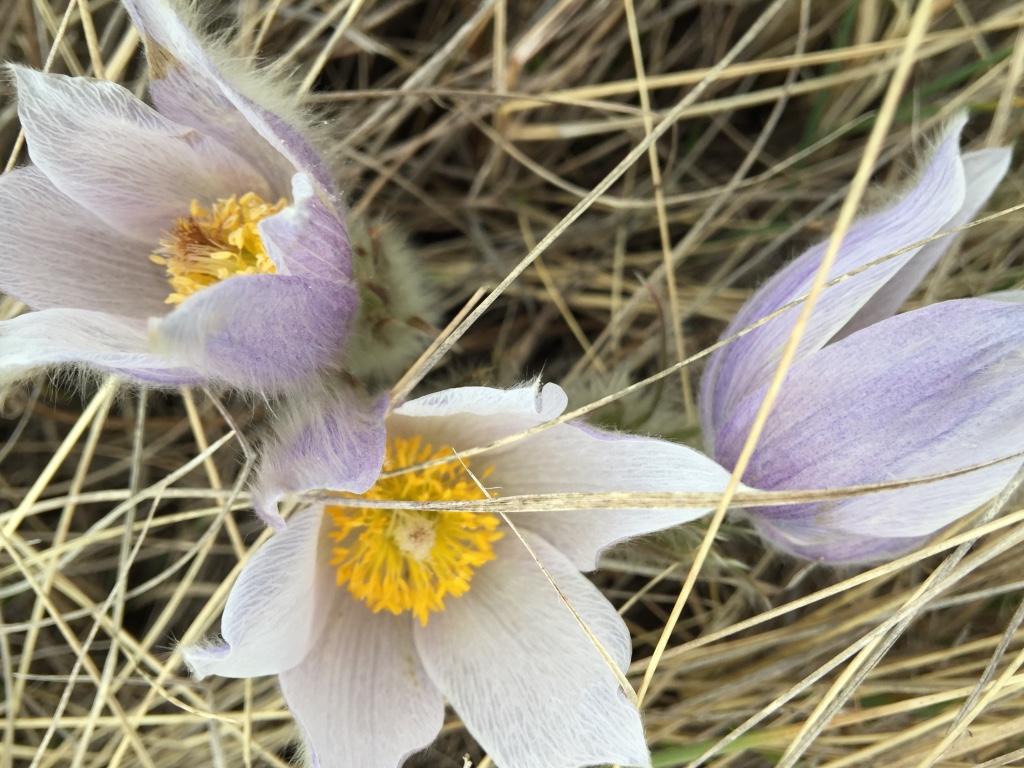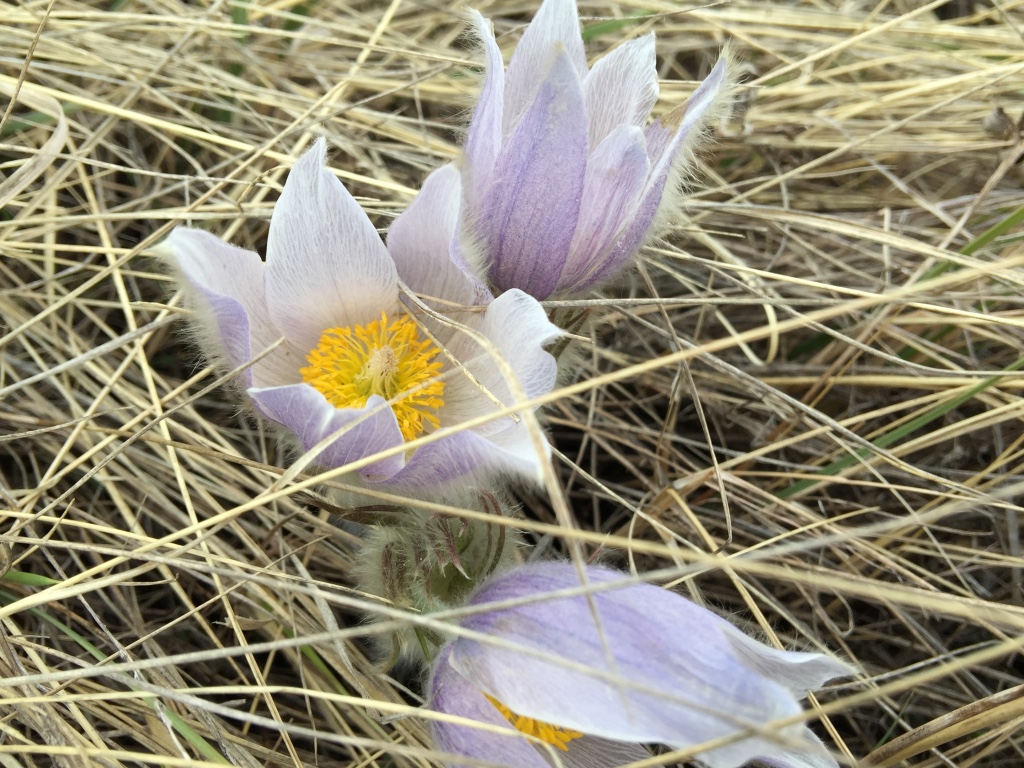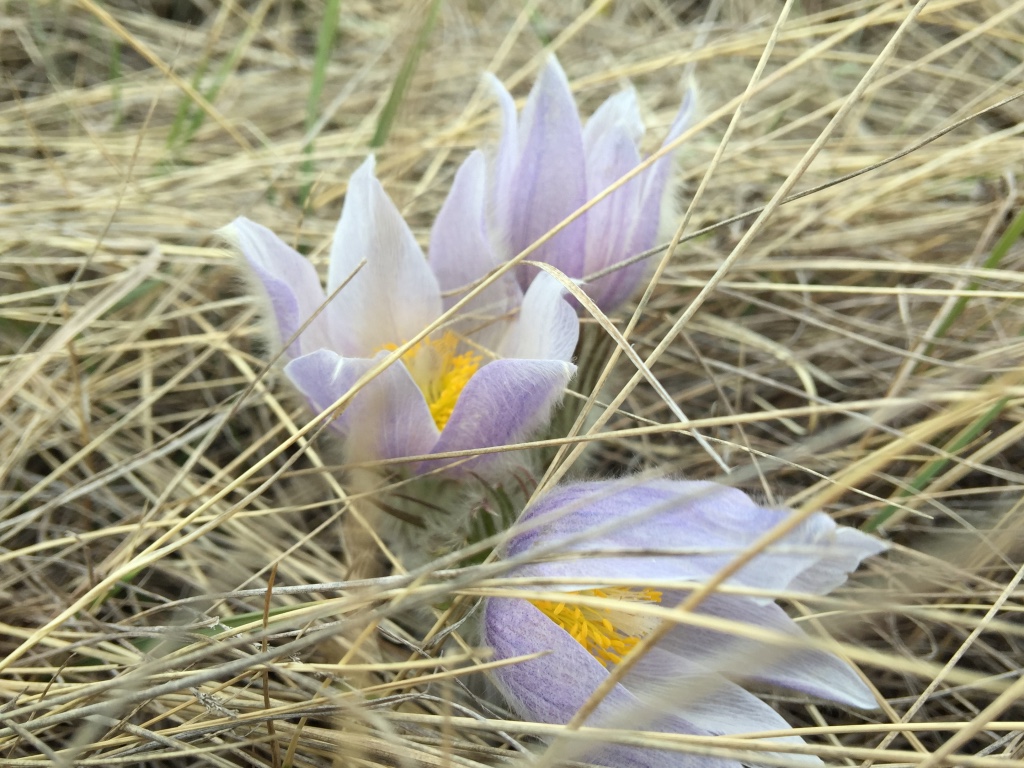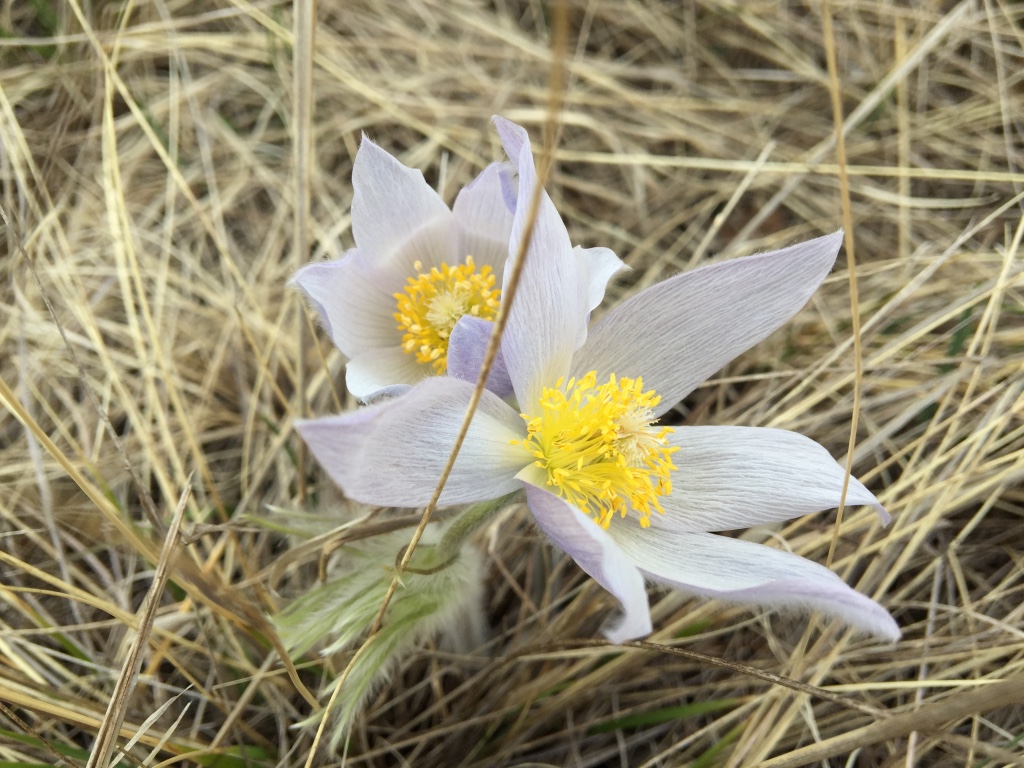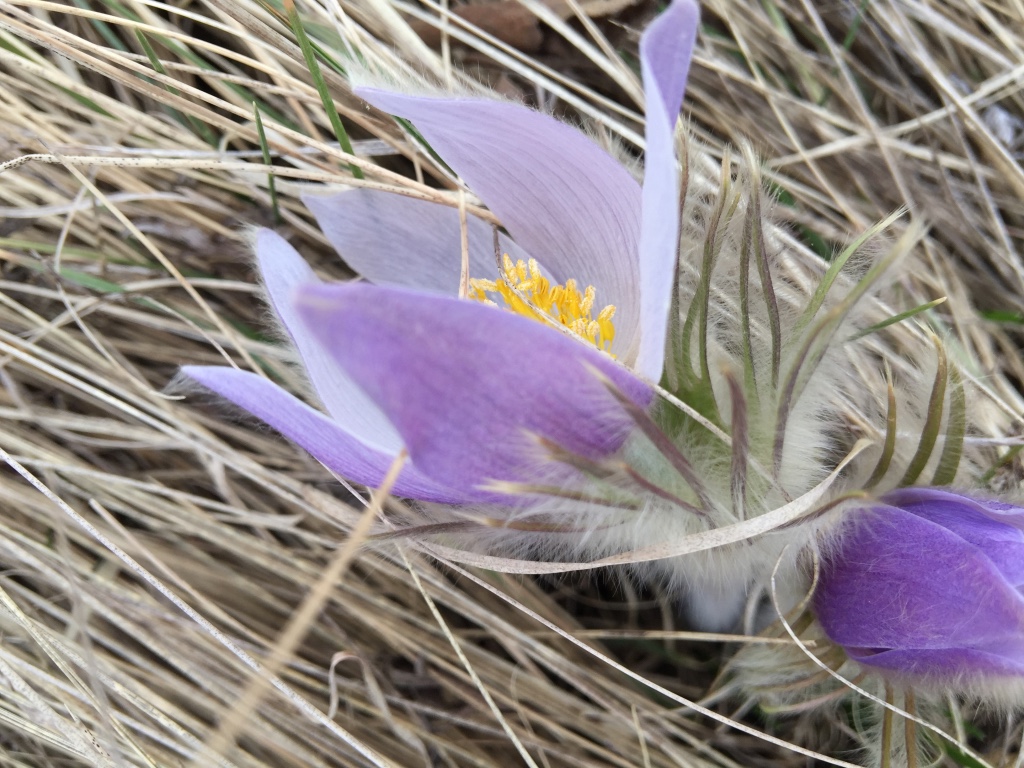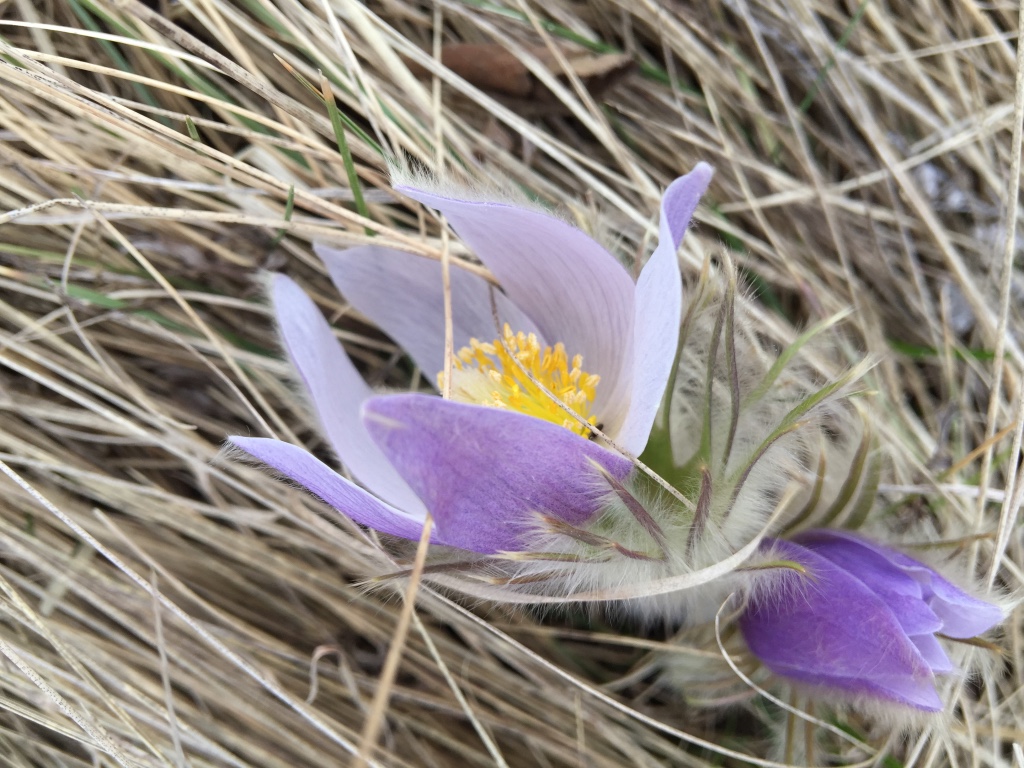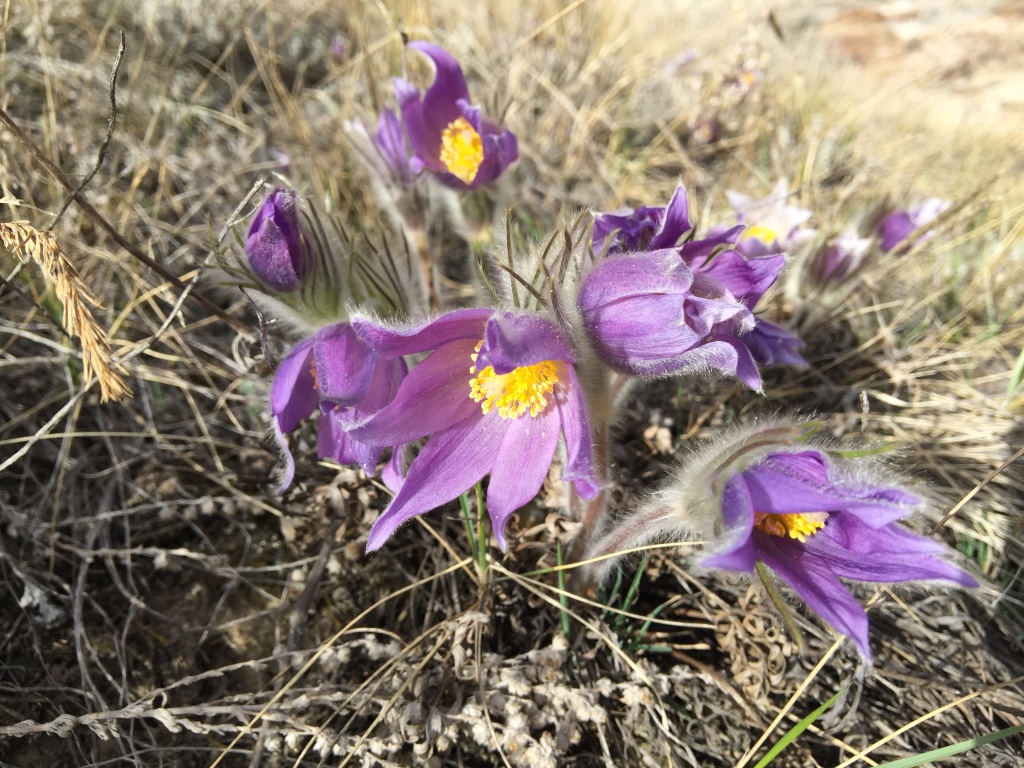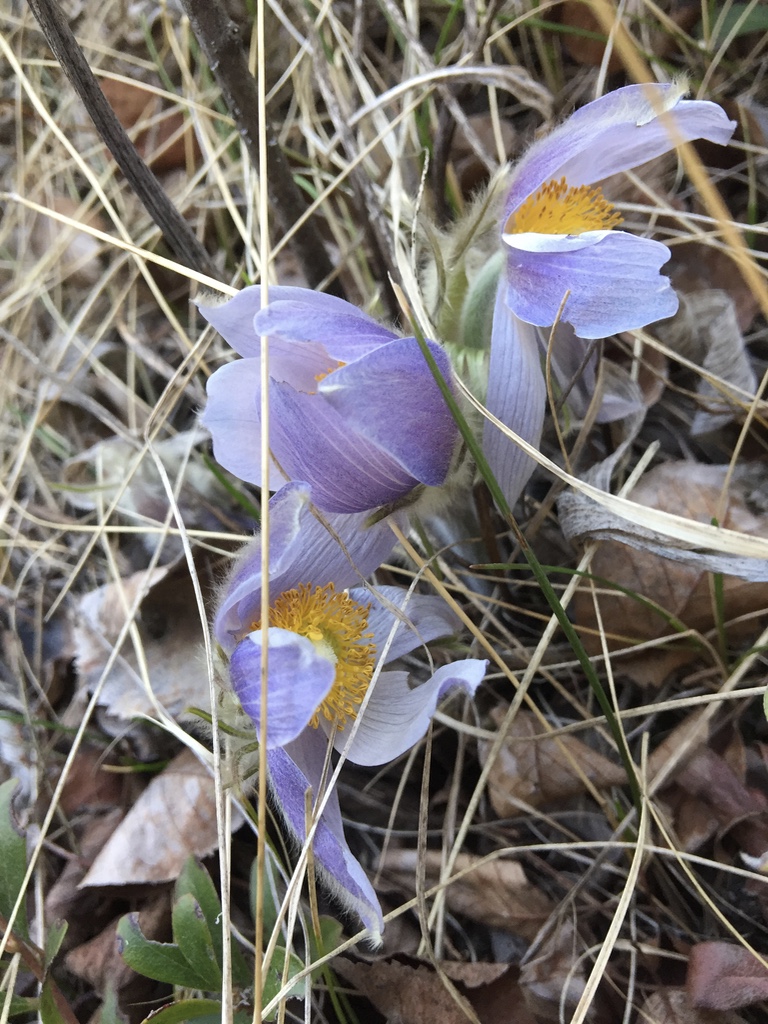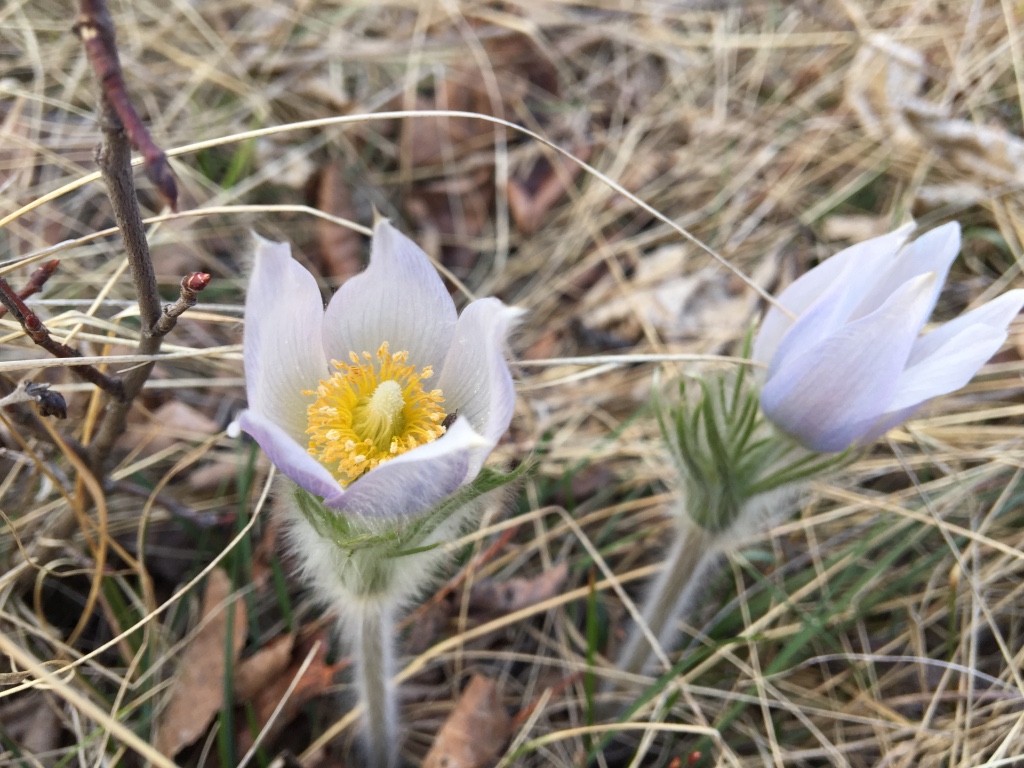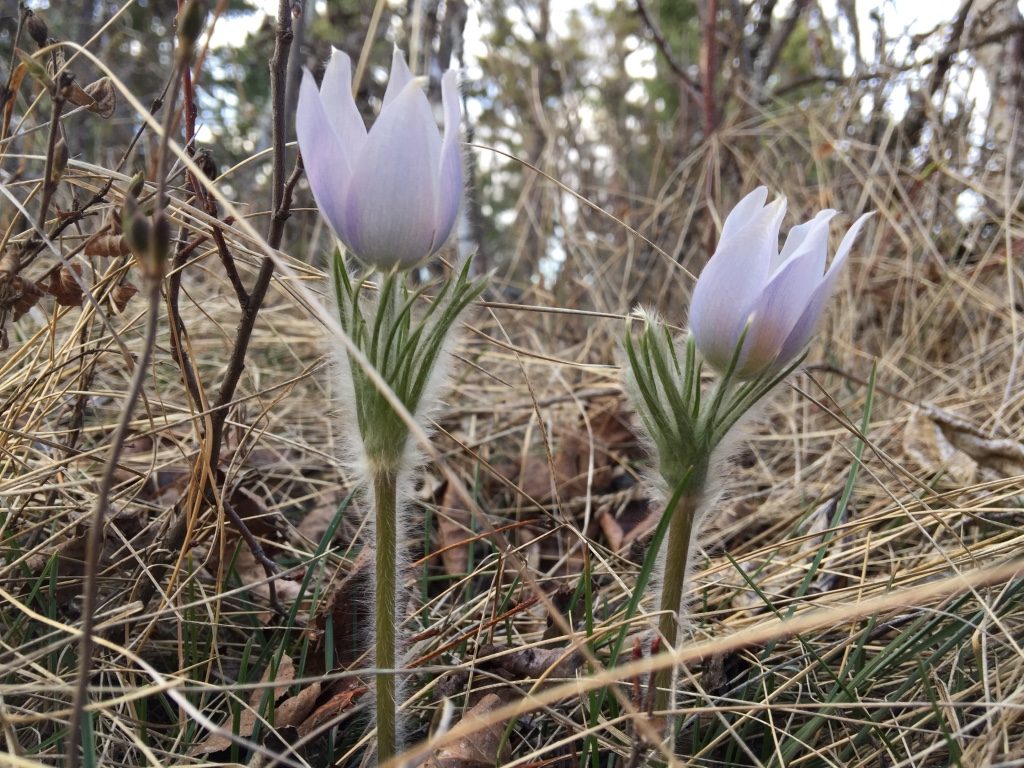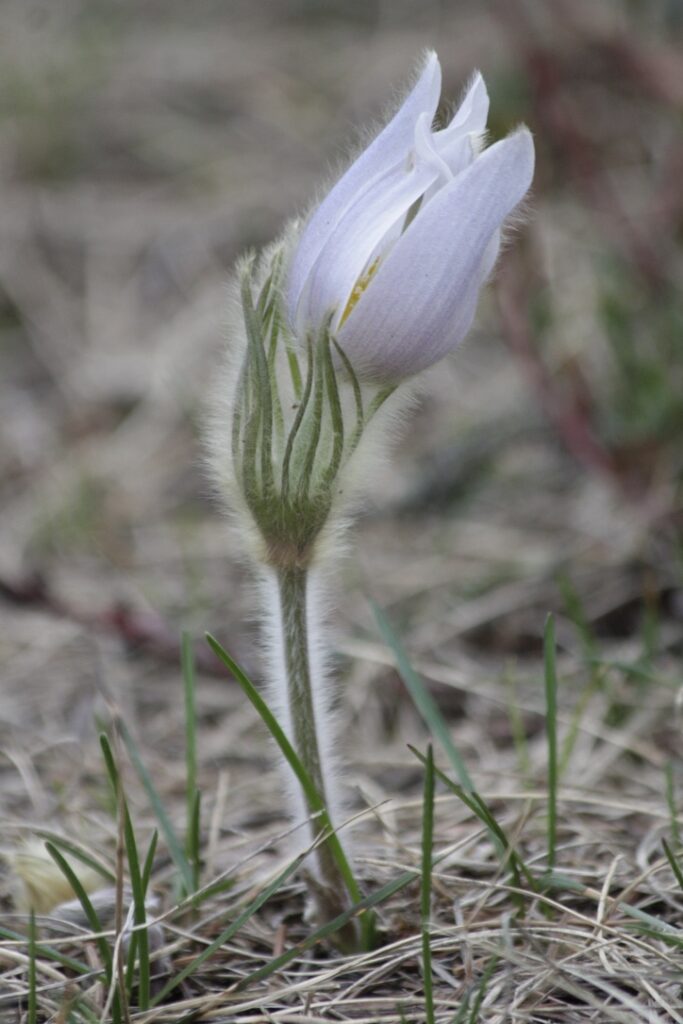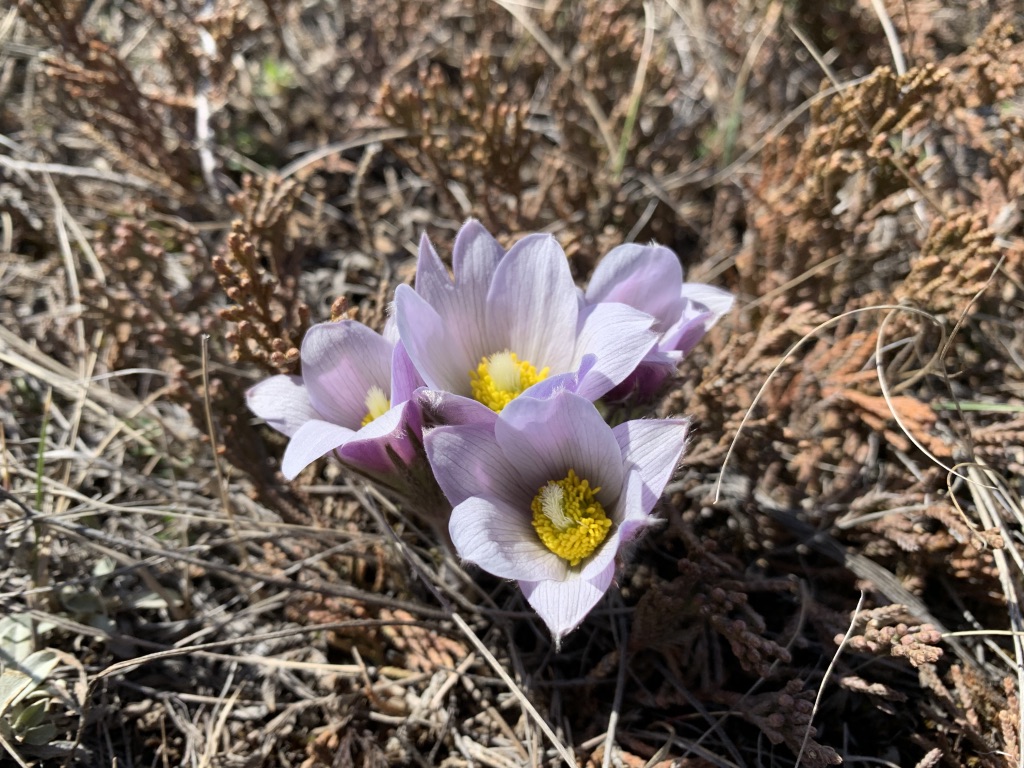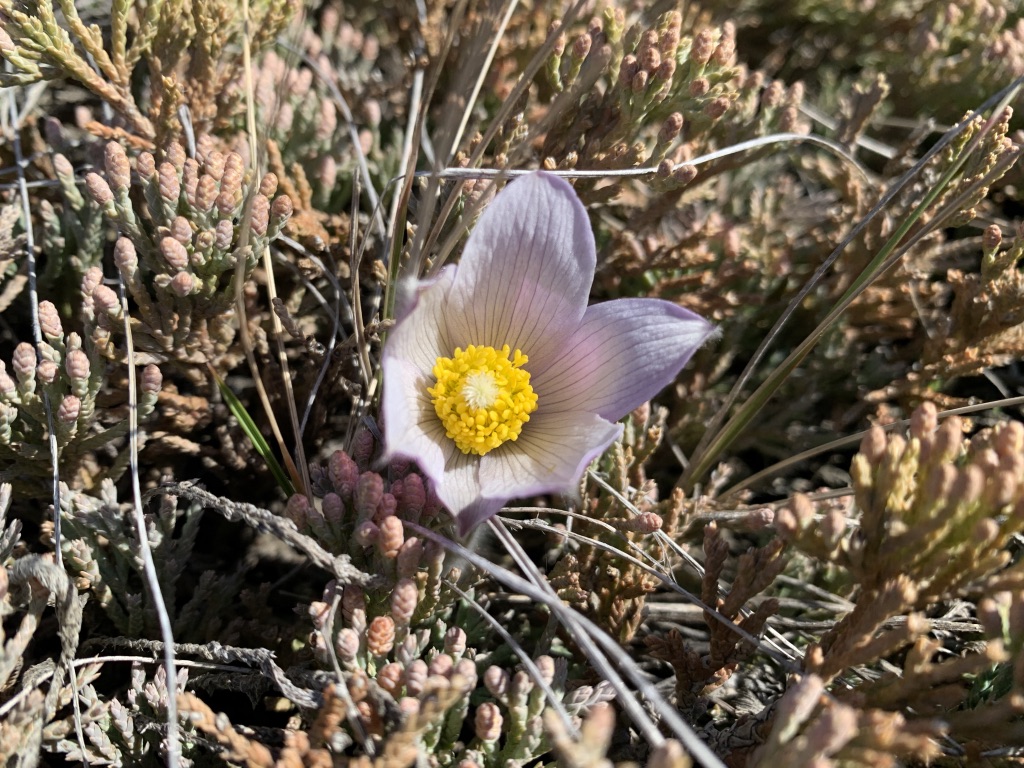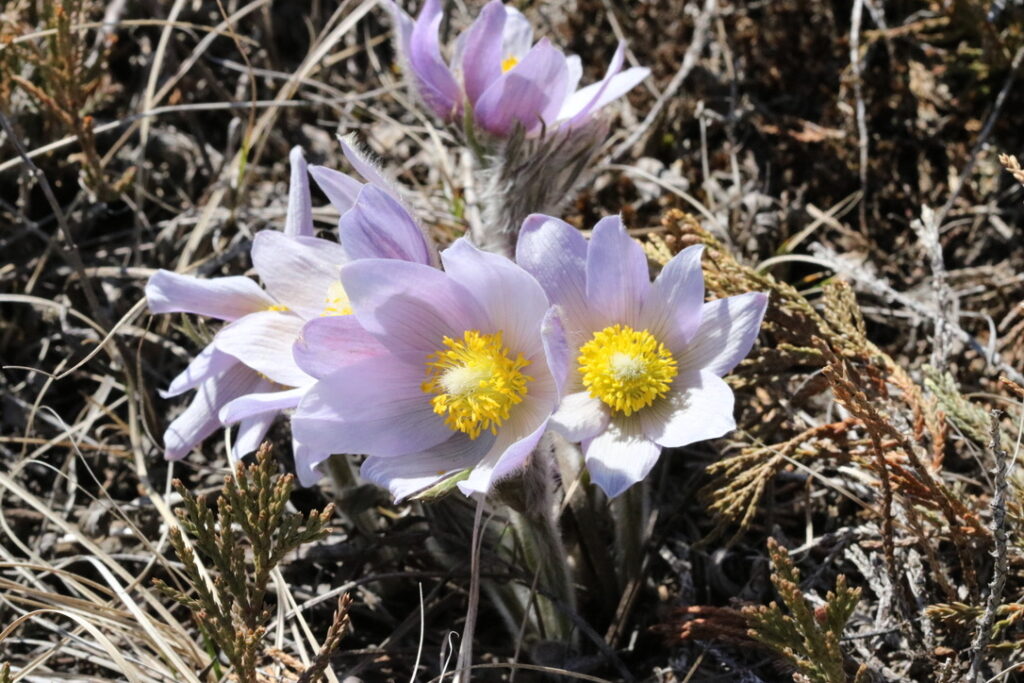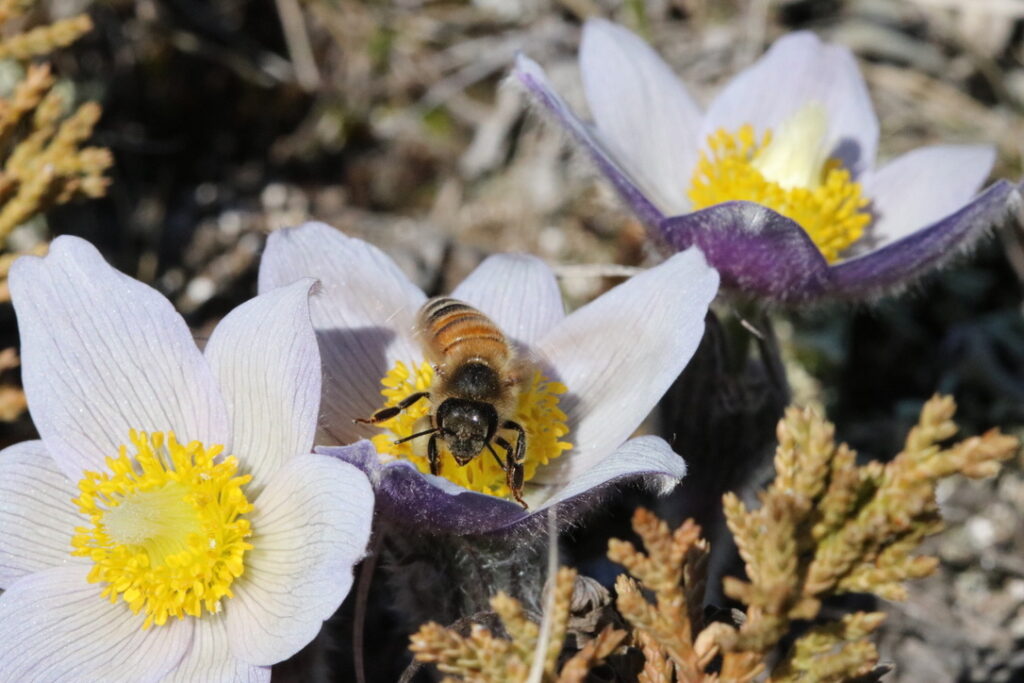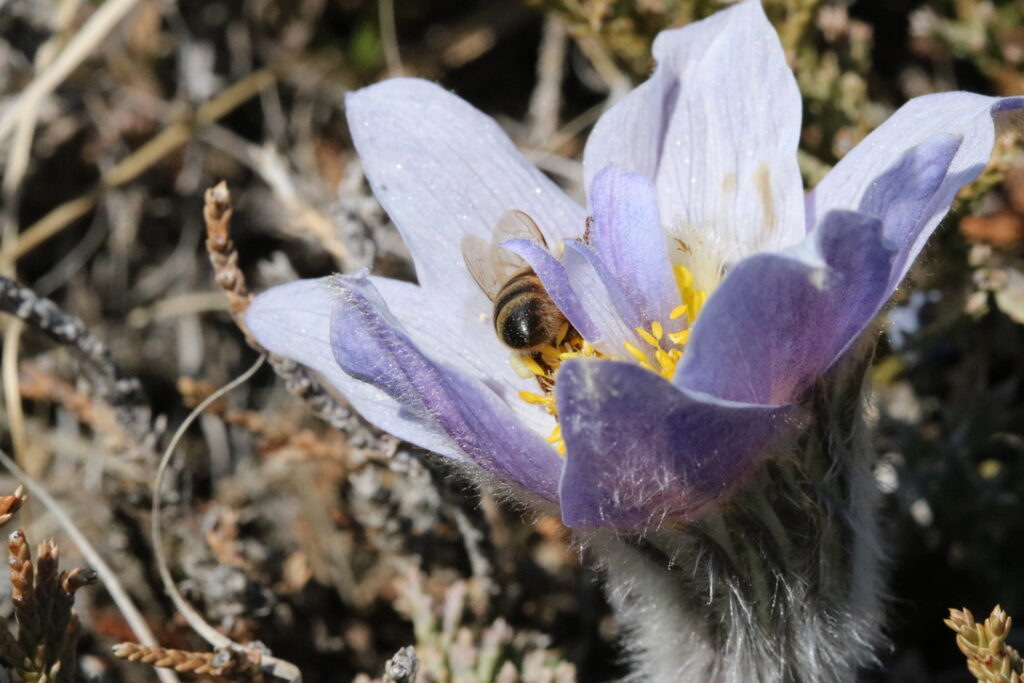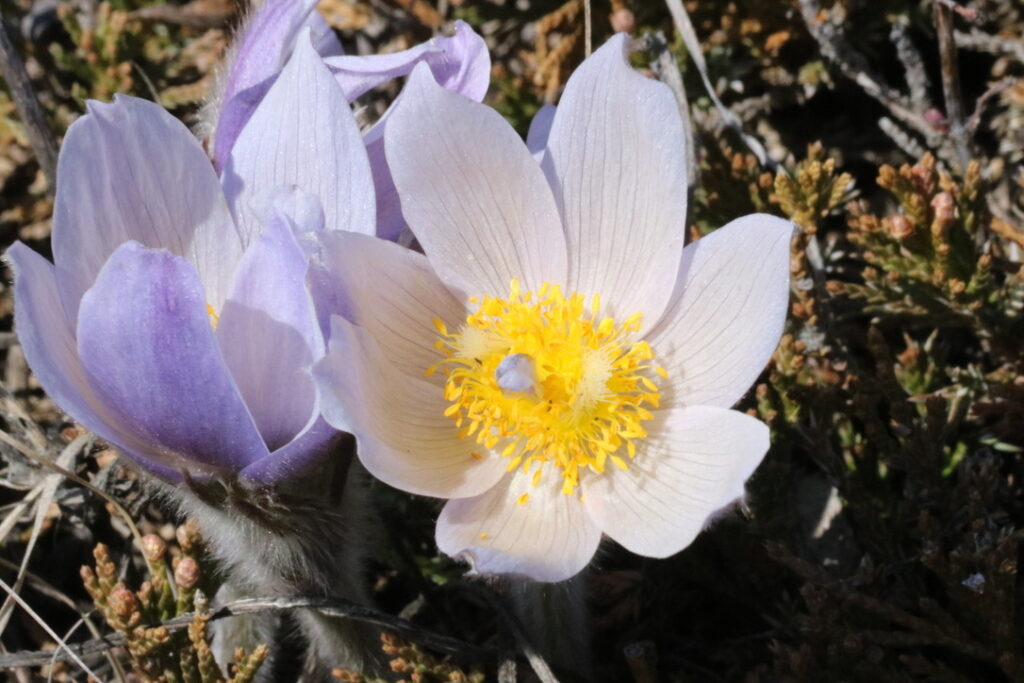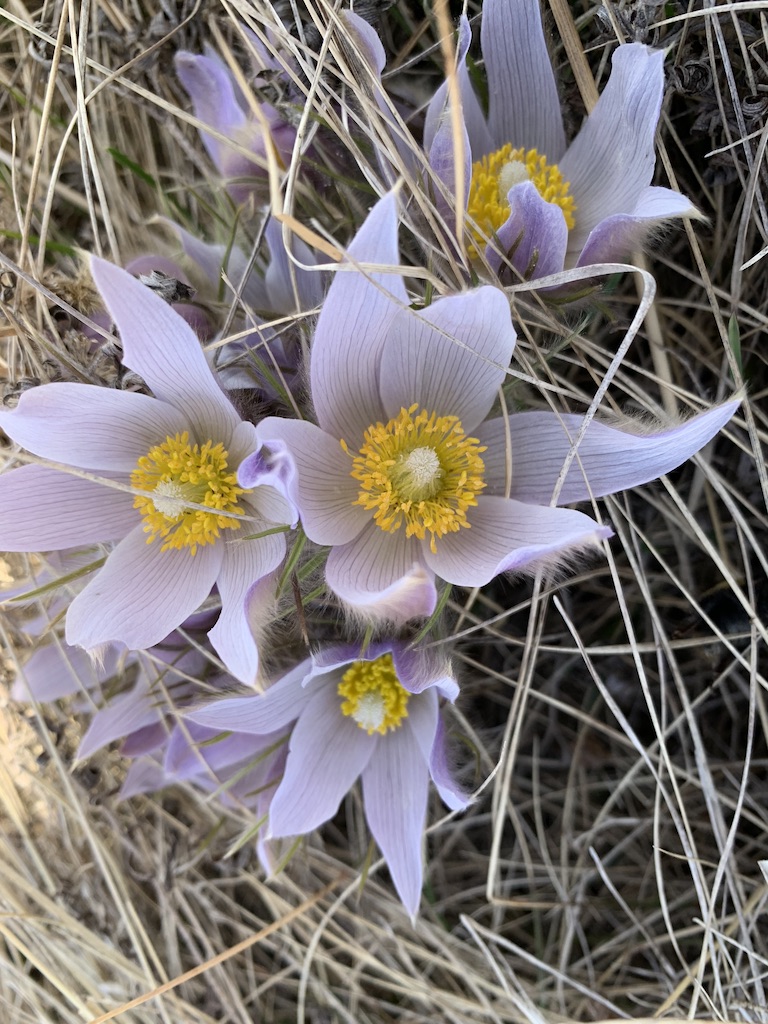Prairie Crocus – Pulsatilla nuttalliana (DC.) Spreng
Family Ranunculaceae
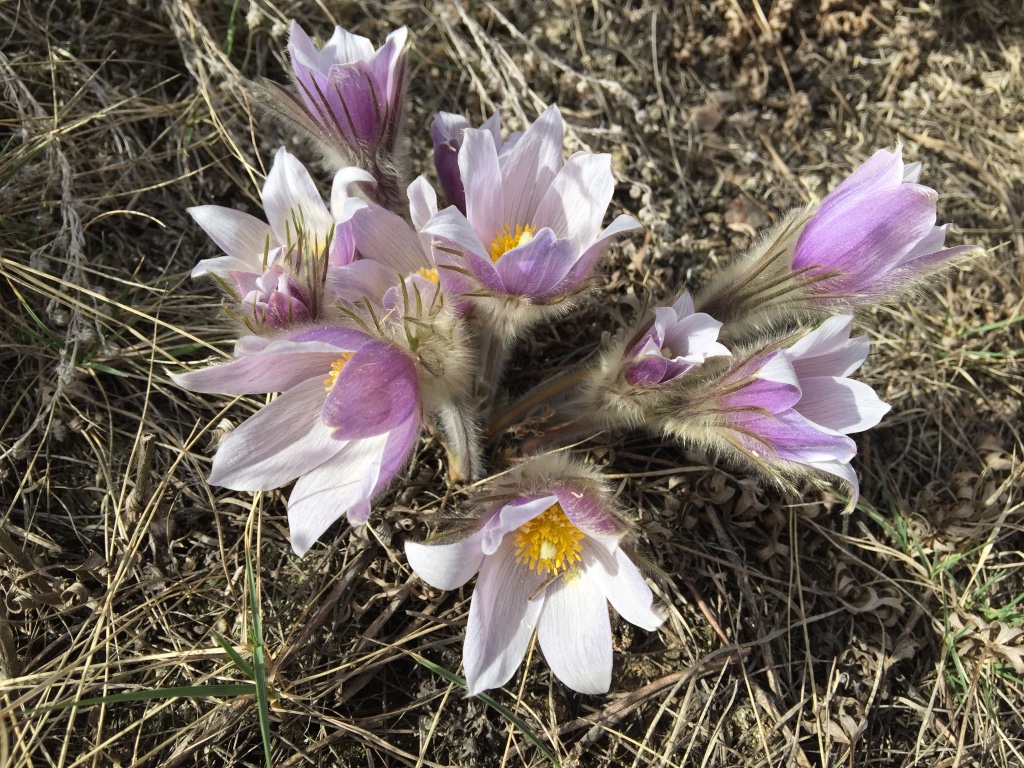
Synonyms or Other Names:
Old synonyms include Anemone patens and Pulsatilla patens. Newer synonyms include Pulsatilla patens ssp. multifida, and Anemone patens ssp. multifida. Homotypic synonyms include Anemone nuttalliana (DC.) and Anemone patens var. nuttalliana (DC) A. Gray.
Also known as Pasqueflower, American Pasqueflower, Cut-leaf Pasqueflower, Prairie Pasqueflower, or Western Pasqueflower.
Pasqueflower is used in the States because it tends to bloom around Easter. Historically, before the 1920s, it was called prairie smoke, hartshorn plant, gosling, or simply crocus. The name “crocus” is not to be confused with the Eurasian native (and garden ornamental) Crocus (Crocus spp.), which is a member of the Iridaceae Family (or Iris Family).
Origin & Status:
Common. Native to North America.
Notable Features to Identify:
P. nuttalliana stands erect between 5 to 40 cm (2 to 14 inches) tall and is born from a caudex base with one to several stems. It has long, spreading hairs on both leaves and stems that can be sparse or dense. The bases are often covered with the previous year’s old brownish growth.
Several long-stalked basal leaves appear after the flowers emerge. These leaves are typically three times divided, with the middle segment being three-cleft and the lateral ones tending to be more two-cleft. These divisions are cleft again into pointed, linear segments 1 to 2 mm wide. These blades contain sparse to densely spreading, long hairs on both sides and down the stalks. There are also involucre leaves at the base, but these have no stalks (are sessile).
The flowers are solitary, with pale blue to purple sepals that are hairy at the back and hairless in front. There are usually five sepals (rarely up to seven), each between 2.5 and 4 cm long. Stamens (150 to 200) have bright yellow anthers surrounding the many-numbered styles that are persistent and are white or cream. The seeds are enclosed in round, globe-like pods and covered in sparse to dense long hairs. P. nuttalliana is often taller when in seed than in flower.
When & Where to Find this Plant?
The prairie crocus is a perennial forb. It can be found in all except the Subalpine ecoregions in Alberta. It prefers deep, well-drained soils, including sandy soils, especially on hillsides or tops of cliffs where the snow is most likely to disappear the soonest in the spring. They are also found in dry, open mixed-wood forests in montane regions and at higher elevations in pine forest communities.
P. nuttalliana tends to bloom shortly after snowmelt, typically between late March to early May. It is rarely found blooming in summer. Occasionally, some blooms may be found in the autumn if there has been adequate late-season moisture to encourage growth and blooming. Its bloom period is greatly affected by altitude.
Is This Species Edible, Medicinal or Toxic?
P. nuttalliana is toxic, especially when fresh. It will irritate the skin (inflammation and blistering) if applied externally to the skin and acts similar to food poisoning if taken internally, causing vomiting and diarrhea. The mouth will also get irritated when this plant is consumed. This is because the plant, when injured, releases the highly unstable glycoside ranunculin, which breaks down into glucose and the volatile toxin protoanemonin. Despite its toxicity being considered “mild,” please do not consume any part of this plant at any time. It is equally poisonous to humans as it is to animals.
The toxin is said to be most volatile when in fresh plant tissues but becomes harmless when dried or thoroughly cooked. However, caution should still be expressed if handling plants that get injured.
However, this species has medicinal properties worth noting. Crushed P. nuttalliana leaves have been applied by some First Nations to relieve irritation of rheumatic joints. Minute doses have been used by homeopaths to treat eye problems, rashes, rheumatism, menstrual obstruction, bronchitis, asthma and coughs. Some herbalists recommend P. nuttalliana alcohol extracts as an antidepressant sedative. Overdoses can cause nausea, dizziness, salivation, and lowered blood pressure.
What Other Species Can This Be Confused With?
Prairie Crocus may get confused with Cut-leaved Anemone (Anemone multifida), Chalice Flower (Anemone occidentalis), and Long-fruited Anemone (Anemone cylindrica). All species are not nearly as fuzzy as P. nuttalliana and tend to bloom later in the spring and summer, long after the snow has disappeared. A. multifida and A. cylindrica have broader leaf segments that are often double that of P. nuttalliana, and A. occidentalis has leaves many times divided leaves, many more than Prairie Crocus. Sepals of all three similar species are white to blue-tinged (A. occidentalis), greenish-white (A. cylindrica), or white to pink to red-purple or even yellow (A. multifida).
Prairie crocus may be confused with the Eurasian/North African native Crocus genus, all members of the Family Iridaceae. Their leaves are linear and glabrous, with a wide arrangement of blues, purples, and pink large five-sepaled flowers. Growth forms from bulbs, not a dense caudex like with P. nuttalliana. This genus has been brought to North America as garden or indoor ornamentals.
Other Interesting Information:
The Dakota language calls this species “hokski-chekpa wahcha,” meaning “twin flower.” In Lakota, it is called “hoksi cekpa” or “child’s navel” in reference to how similar the flower buds appear to a newborn baby’s navel when it is healing. The Blackfoot Nation language calls it “napi” or “old man” for its grey, silky seed heads.
Bumblebees, hoverflies, honey bees, and solitary mining bees of the Andrenidae family are among the many insects that will cross-pollinate P. nuttalliana. Seeds are mainly dispersed by wind or catching on the fur of passing animals (or even pant legs of the unaware hiker).
Value to Livestock & Wildlife
The forage value is poor. It tends to increase under and be an indicator of heavy grazing. It is mainly unpalatable for most of the season. However, deer may consume some flowers. Due to grazing pressure, plants will appear to die down for the rest of the season. Plants remain persistent in areas with little to no grazing, with old growth staying with the re-emergence in the following spring. Persistence is mainly vegetative except when flowering in spring or occasionally in the fall. P. nuttalliana is also adapted to fire.
Suitability/Use for Reclamation
Typically unsuitable due to the challenges of establishing it. The seed does not remain viable for long and must be planted immediately or stored in a cool, dry location. Seedlings are especially challenging as they need to be planted with a substantial amount of soil surrounding the roots. P. nuttalliana are often planted in gardens resembling native prairie habitats or montane rock gardens.
Gallery
